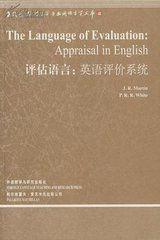作者簡介
作者:(澳)馬丁 (Martin.J.R.) (澳)懷特 (White.P.R.R.)
本書由James R.Martin和Peter R.R.White師生合著。Martin 1950年出生在加拿大新不倫瑞克省聖史蒂芬市,1968年考取多倫多的約克大學格倫頓學院。他從英語系主任Michael Gregory那裡第一次接受了Halliday的語言學思想,同時,又從Henry Allen Gleason,的學生Waldemar Gutwinski那裡接受了關於語篇結構的理論。大學畢業以後,他到多倫多大學師從Gleason進一步學習語篇分析。1975年,他獲得碩士學位後,前往英國艾塞克斯跟隨Halliday攻讀博士學位。這期間他有一年半時間在加拿大跟Gleason做研究,然後隨.Halliday到悉尼,在那裡完成了學業。此後,他一直在悉尼大學語言學系任教。2000年晉升教授,並當選澳大利亞人文科學院院士。2003年因為在語言學和哲學領域的貢獻榮獲澳大利亞聯邦建國百年特殊貢獻獎。
White 1956年出生,曾在澳大利亞的報紙和電台擔任過記者、編輯,並在澳大利亞特別節目廣播事業局(SpeciM Broadcasting Service,SBS)擔任過培訓新聞工作者的教官。1998年他以論文((講述媒體故事——作為修辭的新聞故事》(’Telling media tales:the news story as rhetoric)在悉尼大學獲博士學位。此後,他在英國伯明罕大學講授了7年語言學和英語課程,現在澳大利亞阿德萊德大學語言學系擔任講師。
兩人的學術背景決定了他們的學術興趣。他們對系統功能語法和語篇分析都有精闢、獨到的研究,因此特別關注如何把這兩者進行有機的結合。Martin從1979年開始在悉尼大學講授自己對這個問題的認識,把這門課稱為“語篇語義學”(discourse semantics)。1992年他把這門課程的講稿整理出版,定名為《英語篇章——系統與結構》(English Text?System and跏ucture)。
內容簡介
《評估語言:英語評價系統》(英文版)以嶄新的視角揭示了評估性語言的本質及其社會功能和修辭功能,重新詮釋了情態、讓步、否定等語義學概念,並通過對選自新聞、政治報導、學術著作、小說等文本的分析,清晰闡明了評價系統在文本分析中的套用,是了解、研究語篇語義學的必讀書目。
目錄
List of Figures
List of Tables
Acknowledgements
Preface
1Introduction
1.1Modelling appraisal resources
1.2Appraisal in a functional model of language
1.3Situating appraisal in SFL
1.4Appraisal - an overview
1.5Appraisal and other traditions of evaluative language analysis
1.6Outline of this book
2Attitude: Ways of Feeling
2.1Kinds of feeling
2.2 Affect
2.3 Judgement
2.4Appreciation
2.5Borders
2.6Indirect realisations
2.7Beyond attitude
2.8Analysing attitude
3Engagement and Graduation: Alignment, Solidarity and the Construed Reader
3.1Introduction: a dialogic perspective
3.2 Value position, alignment and the putative reader
3.3 The resources of intersubjective stance: an overview of engagement
3.4 Engagement and the dialogistic status of bare assertions
3.5Heteroglossia: dialogic contraction and expansion
3.6Entertain: the dialogistic expansiveness of modalityand evidentiality
3.7 Dialogistic expansion through the externalisedproposition - attribution
3.8The resources of dialogic contraction - overview:disclaim and proclaim
3.9 Disclaim: deny (negation)
3.10Disclaim: counter
3.11Proclaim: concur, pronounce and endorse
3.12Proclaim: concur
3.13Proclaim: endorsement
3.14Proclaim: pronounce
3.15Engagement, intertextuality and the grammar ofreported speech
3.16Graduation: an overview
3.17Graduation: focus
3.18Graduation: force- intensification and quantification
3.19Force: intensification
3.20Force: quantification
3.21Force (intensification and quantification),attitude and writer-reader relationships
3.22Analysing intersubjective positioning
4Evaluative Key: Taking a Stance
4.1 Introduction
4.2 Evaluative key in journalistic discourse the 'voices' of news, analysis and ommentary
4.3 Evaluative key and the discourses of secondary-school history
4.4 Stance
4.5 Signature
4.6 Evaluation and reaction
4.7 Coda ...
5Enacting Appraisal: Text Analysis
5.1 Appraising discourse
5.2 War or Peace: a rhetoric of grief and hatred
5.3 Mourning: an unfortunate case of keystone cops
5.4 Envoi
References
Index

